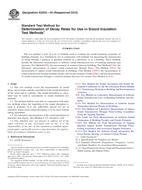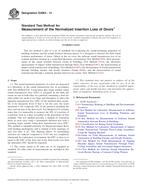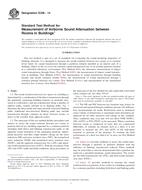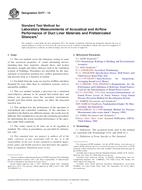Potřebujeme váš souhlas k využití jednotlivých dat, aby se vám mimo jiné mohly ukazovat informace týkající se vašich zájmů. Souhlas udělíte kliknutím na tlačítko „OK“.
ASTM E2249-02(2008)
Standard Test Method for Laboratory Measurement of Airborne Transmission Loss of Building Partitions and Elements Using Sound Intensity
Automaticky přeložený název:
Standardní zkušební metoda pro laboratorní měření Airborne neprůzvučnost stavebních oddílů a prvků pomocí intenzity zvuku
NORMA vydána dne 1.10.2008
Informace o normě:
Označení normy: ASTM E2249-02(2008)
Poznámka: NEPLATNÁ
Datum vydání normy: 1.10.2008
Kód zboží: NS-44793
Počet stran: 15
Přibližná hmotnost: 45 g (0.10 liber)
Země: Americká technická norma
Kategorie: Technické normy ASTM
Kategorie - podobné normy:
Anotace textu normy ASTM E2249-02(2008) :
Keywords:
roofs, panels, building industry, floor, floor-ceiling, doors, ICS Number Code 91.120.20 (Acoustics in buildings. Sound insulation)
Doplňující informace
| Significance and Use | ||||||||
|
This test method can be used to obtain an estimate the transmission loss of building elements in a laboratory setting where the source room and the specimen mounting conditions satisfy the requirements of Test Method E 90. The acceptability of the receiving room will be determined by a set of field indicators that define the quality and accuracy of the intensity estimate. By appropriately constructing the surface over which the intensity is measured it is possible to selectively exclude the influence of sound energy paths including the effects from joints, gaps as well as flanking sound paths. This method may be particularly useful when accurate measurements of a partition can not be made in an Test Method E 90 facility because the partition sound insulation is limited by flanking transmission involving facility source and receiver room surfaces, (for example, the path from the source room floor to the receiver room floor via the isolators and the slab supporting the two). Annex A3 discusses this in detail. The discrete point method allows the mapping of the radiated sound intensity which can be used to identify defects or unique features (2) of the partition. Current research reported in the literature indicate that there exists a bias between measures of transmission loss obtained using the intensity technique and those obtained using the conventional two room reverberation technique (for example, Test Method E 90, (3) and (4)). Appendix E provides estimates of the bias that might be expected. Despite the presence of a bias, no corrections are to be applied to the measured data obtained by this test method. |
||||||||
| 1. Scope | ||||||||
|
1.1 This test method covers the measurement of airborne sound transmission loss of building partitions such as walls of all kinds, operable partitions, floor-ceiling assemblies, doors, windows, roofs, panels and other space-dividing building elements. It may also be have applications in sectors other than the building industry, although these are beyond the scope. 1.2 The primary quantity reported by this standard is Intensity Transmission Loss (ITL) and shall not be given another name. Similarly, the single-number rating Intensity Sound Transmission Class (ISTC) derived from the measured ITL shall not be given any other name. 1.3 This test method may be used to reveal the sound radiation characteristics of a partition or portion thereof. 1.4 The values stated in SI units are to be regarded as standard. No other units of measurement are included in this standard. 1.5 This standard does not purport to address all of the safety concerns, if any, associated with its use. It is the responsibility of the user of this standard to establish appropriate safety and health practices and determine the applicability of regulatory limitations prior to use. Note 1—The method for measuring the sound intensity radiated by the building element under test defined by this ASTM standard meets or exceeds those of ISO 15186-1. Special consideration will have to be given to requirements for the source room and specimen mounting if compliance with ISO 15186-1 is also desired as they differ from those of this standard. |
||||||||
| 2. Referenced Documents | ||||||||
|
Podobné normy:
Historická
1.4.2012
Historická
1.5.2010
Historická
1.6.2014
Historická
15.4.2014
Historická
1.9.2010
Historická
1.6.2013
Doporučujeme:
Aktualizace technických norem
Chcete mít jistotu, že používáte pouze platné technické normy?
Nabízíme Vám řešení, které Vám zajistí měsíční přehled o aktuálnosti norem, které používáte.
Chcete vědět více informací? Podívejte se na tuto stránku.



 ASTM E2235-04(2012)..
ASTM E2235-04(2012).. ASTM E2638-10
ASTM E2638-10 ASTM E2964-14
ASTM E2964-14 ASTM E336-14
ASTM E336-14 ASTM E413-10
ASTM E413-10 ASTM E477-13
ASTM E477-13
 Cookies
Cookies
